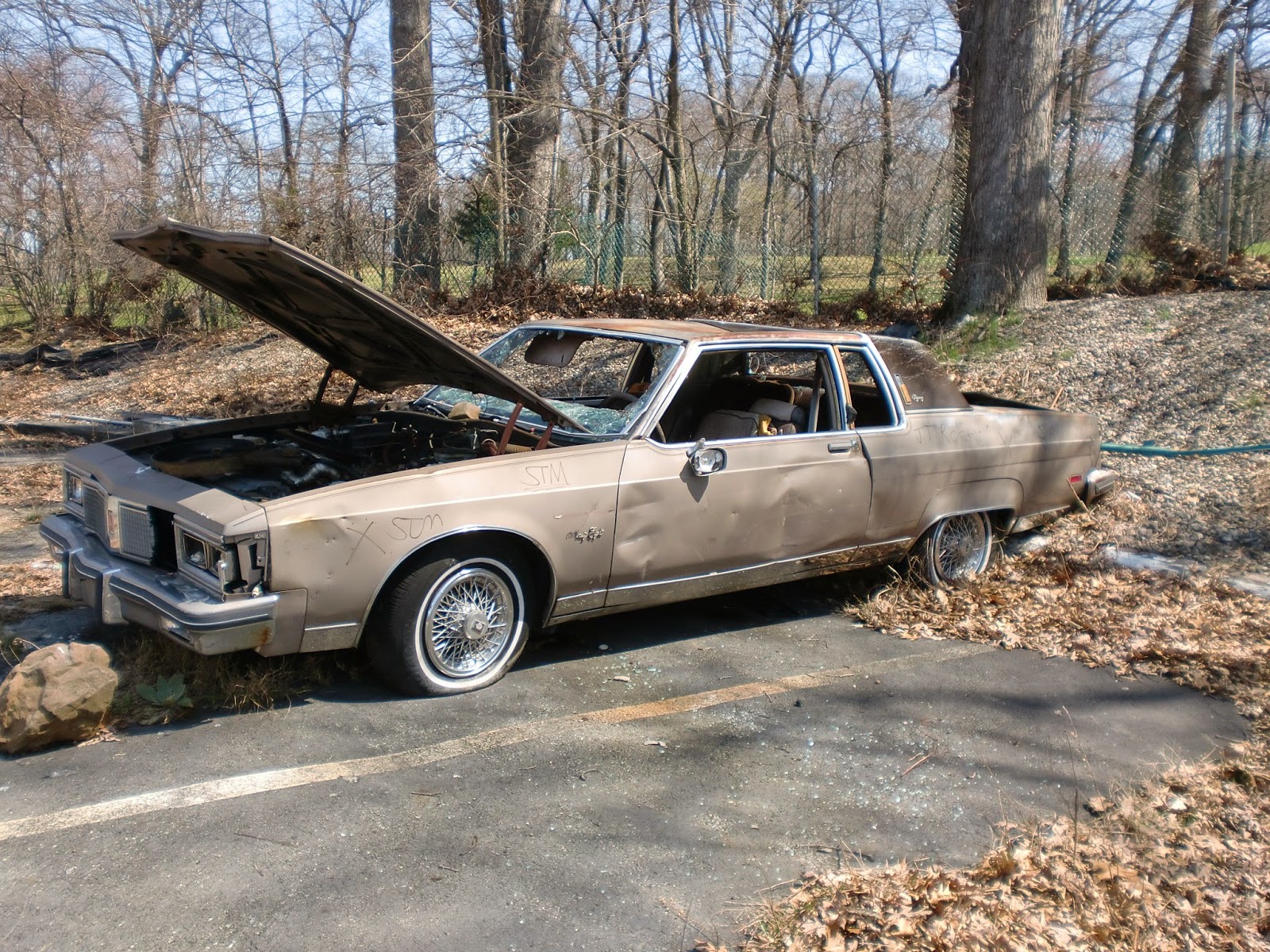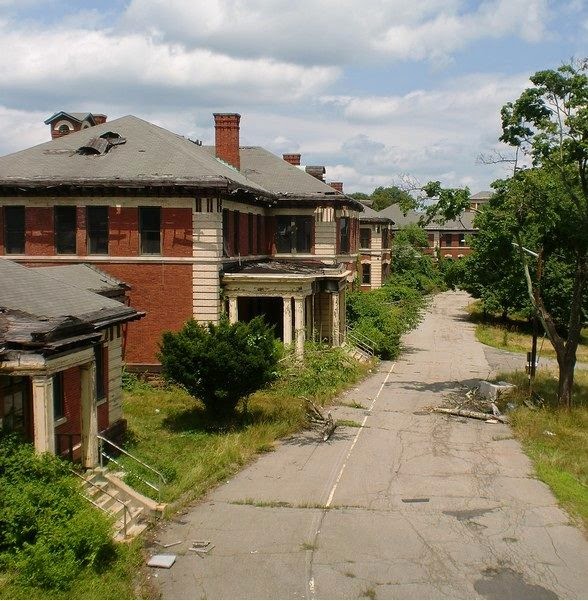This historic North Jersey Psychiatric Hospital took patients from all over the state, as well as transfers from other psychiatric hospitals, mostly on the east coast.
What started as one big building, and few other small buildings, soon spread into a vast campus of about 120 acres.
The Essex County Board of Chosen Freeholders purchased the tract of land from farmers in 1896, right on the other side of the mountain from the Essex County Jail Annex. Construction began immediately, and before long, the Star Building was built. It was named the star building because it looked like a star from above (So they say, I don't think it does). Eventually, the wards in the Star Building were very overcrowded, so construction began at the campus. It was around this time that I believe building 11 was built, and then shortly after in 1909 the "Hill Wards" were built, which were buildings 1-10. The architects responsible for the expansion were the Newark firm of Hurd & Sutton. The pair had also done work at both
Greystone Park Psychiatric Hospital and the
Essex County Isolation Hospital. The Overbrook campus, however was going to be their greatest work.
Other buildings built were a larger powerhouse, a larger firehouse (Built in 1915), staff housing, and other miscellaneous buildings.
With the huge influx of patients with PTSD after both world wars, the hospital found itself unable to care for so many people. There were patients in day rooms filled way past the maximum capacity.
Conditions were deplorable, and the hospital was struggling to keep up with the huge amount of patients. Anti Psychotic drugs became more advanced and helpful, and soon the population of patients was dwindling.
Buildings 30-45 were emptied of their residents, and in some cases used for storage, but they weren't maintained properly.
Finally, on 2/27/ 2007, the last few patients were discharged from the hospital, and the hospital closed its doors for good. It continued to be a spot for local teens to hang out, and it even worked it's way into pop culture when it was featured in 3 ghost hunting shows and 4 movies. The parcel of land where Buildings 30-45 stood was sold to a developer, and the buildings were abated and demolished one by one.
There were a lot of buildings here, so here is a rundown of how the property was laid out.
The main campus was the Star building, and buildings 1-14. The first five buildings were the wards, built in 1909. Buildings one and two were for female patients, while four and five were for the men. Building three was split, housing both men and women. It was also where the dentist was located, and was close to the chapel and library. It was the victim of arson in August of 2013.
Building 6 was the Administration building. It was built in 1909, and renovated sometime between the 1930's and 1960's. The building was given an extra wing, which is the part of the building angled towards the the street, a new glass and concrete entrance to replace the stone one, and a new roof.
Directly behind building 6 was a mixed use building whose main purpose was to connect the administration building to the wards. It held the chapel, group meetings, a cafeteria, one of the hair salons, and the library. Though nothing more than a glorified hallway, it is referred to as building 7.
Buildings 8, 9, and 10 were the dining group. Building 8 was the main kitchen, where food was prepared and sent down a long hallway to either the female (9) or male (10) dining halls. In the later years of the hospital, buildings 4, 5, and part of building 3 were just used for storage. Because of this, the long tunnel that once ran almost the whole span of the hospital was cut off at building 9.
Building 11 was the "Reception Ward" at its inception, but by the time the hospital closed it was being used to house the criminally insane. I believe it is the oldest ward building still standing on campus, most likely dating back to the last years of the 19th century. It is where the morgue was, as well as another cafeteria/kitchen, another hair salon, game room, and other services for the patients.






The last building built on campus was building 12. Dating back to 1979, it was built on the site of the former main "Star" building which was demolished between 1978-79. It is an ugly, almost Brutalist design, and hold the pools, pool tables, basketball courts, bowling alley, and offices as well. It was used as record storage after the hospital closed, and suffered a fire in April of 2012. The wanna be arsonists torched the basketball court, luckily no structural damage was recorded. Original plans called for the building to be re-used by the local wrestling team, but the current state of the building probably wont allow for that.




Building 13 was a trade building, having held a bakery, tailor, electrical workshop, and other various workshops. It was the first to almost be burned down in 2008. Some teens from Perth Amboy were seen fleeing the campus after smoke began rising from the building, and they were eventually caught and tried. Unfortunately I never made it inside this building, it was demolished during the first wave that took out most of the buildings closest to the Verona side of campus. The footprint can still be seen from building 11.
The last building in the group was the Freeman Pavilion, building 14. It was original built as a tuberculosis pavilion for psychiatric patients, but it was later occupied by a vocational program and the Turning Point rehabilitation group after they were forced to vacate their building at the Essex Mountain Sanatorium. It was the first building on campus I ever got into, and also the first building demolished when the county started taking structures down in 2008.
There is also the powerhouse group, made up from buildings 21-23. Building 21 is the new powerhouse, built after the old one was just not enough to power the rapidly expanding complex. Building 22 is the mechanics shop, which has actually been renovated into an ugly stucco and tar building whose only purpose is for the county workers to have a place to punch in and out. Building 23 is the paint shop for the campus, and is hard to see because it sits behind the former mechanics shop.



The horticultural therapy group was the hospital caretakers house, the gardens, and the greenhouse. The caretakers house was vacated, and a county run gang awareness group filled the structure for a couple of years before they eventually moved out too. I don't have any photo's from inside this group due to a friend deleting them before I had a chance to upload them.
Building 30, the first building one would have passed while driving through campus from the Verona side, was the hospital administrator's house. It was a small mansion, and was used for a period of time after it was emptied as a haunted house attraction. After they stopped doing that, the building was stripped of anything of historic importance and used for police training. It was demolished March 21st, 2011.
The next building along the road (and the only structure still left on that side of the street) is the fire apparatus house. Built in 1915, this castle like structure has been given to the town of Cedar Grove. It is supposed to be restored and re-used by the town, but so far nothing has come of that. There is a short stretch of tunnel in the basement of the building, which runs until the area where the next building down was demolished.

Also along Fairview Avenue were a number of buildings used for staff housing. The original female employees home was building 32, a small 2 story brick dormitory. It changed purposes before its official closure, renamed "The Gateway". The inside was too rotten for us to make it very far off the stairwells, but the building was empty anyway. It was demolished sometime in the spring of 2011.
Set back from the gateway building, the PEER building was the highest point of the hospital complex, not counting the smokestack of the powerhouse. It was built in 1950 as the student nurses home, but was converted into offices before being emptied sometime in the 2000's. It was taken down over a series of months starting on September 28th, 2011 and was completed on December 12th of the same year.
Next to the PEER building was the graduate nurses home, later becoming a replacement for the original female employees home. It was the largest building on the side of the campus it sat on, standing 3 stories tall. This building sat empty for decades before the hospital shut its doors, leading to advanced deterioration. It was demolished in 2011 with the rest of the Fairview Avenue buildings.





After driving past the Female Employees Home, one would pass a couple of empty lots before arriving at the next building. There used to be two structures here, an auditorium and one of the Male Employee's Homes. The auditorium, building 35, was apparently very nice. However, it had been used for storage and not taken care of. It was taken down, along with the larger Male Employees Home without warning one day in the 1980's, which did not go over well with the staff and families still living on the hospital grounds. However, they would soon be forced to vacate the buildings they lived in themselves a few short years later in 1987.
The last big building on the left side of the street was Rawson Hall. It was built in 1950, along with the PEER building, and was built to replace the aging Male Employees Homes. It was the first building on the privately owned side of Fairview to be demolished. Built at a cost of $485,000, it was only used for a few decades before becoming offices, and it was also used for swat training after its official closure. This is the last building on the street to be connected to tunnels, although the collapse of the Female Employees home made them impossible to traverse.
The structure next to Rawson Hall looked like a diner, but it was really a two family doctors home. It was in very bad shape prior to its demolition. We could only walk around the kitchen and living room areas before the ground was too soft to continue.
And finally, the doctors houses were the last few buildings on this side of the street. They were small, but really nice. They were used up until 1987, when the occupants were forced out and the buildings were used for "storage". After they had begun demolition, they spared two doctors houses and moved on to the other buildings. I was thrilled, I figured they were going to renovate these two houses for use in the condo complex. It turns out they were just behind schedule, and the other two houses were demolished a few short weeks later.


A few other buildings on campus were the laundry building, the old male employees home, a separate morgue, and some other miscellaneous buildings which were mostly all demolished long before I was around to document the hospital. The maintenance garages and sewage pumping station on Bradford were also once part of the Overbrook property, as well as the daycare center on Grove. Unfortunately they too are being demolished in favor of ugly new replacements. My only hope is that they one day have some sort of memorial for the hospital once the grounds have been converted into a park. As much as the county would like it to be true, you can't change history by demolishing it.












































































































